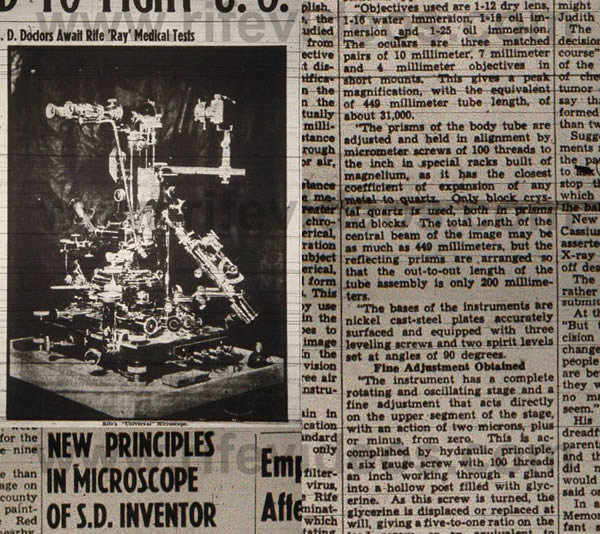New Principles In Microscope Of S.D. Inventor |
New Principles In Microscope
Of S.D. Inventor
San Diego Evening Tribune May 7, 1938
Because of the widespread interest here in optics, resulting largely from establishment of California Institute of Technology's great Mt. Palomar observatory, a detailed technical explanation of microscopes designed and built by Royal Raymond Rife will be appreciated by many San Diegans.
All of the San Diego man's microscopes use similar, new principles, but probably the most interesting and important of his instruments is that term "universal" microscope. Following is a detailed technical description of it Prepared by Rife:
"Four microscopes have been designed and built, with varying equivalent tube lengths of from 200 millimeters to 449 millimeters. An entirely new principal from that used in the construction of the regular research microscope has been employed. The four microscopes vary in peak magnification from 10,000 to 31,000 and give excellent definition and clearness when slides are prepared properly for these tremendous powers; no spherical aberration, chromatic disturbance or distortion of any kind is noticed, even on the finest of test plates. For the greater part of the work on virus, for which these microscopes are being used, a magnification from 6000 to 10,000 is found sufficient.
Small Tolerance Allowed
"These results are obtained by imposing correcting prisms and blocks of quartz at a distance of not more than 30 millimeters apart through the entire system of optics, allowing only a tolerance of less than one wave length of visible light in the core beam of illumination from the objective to the ocular. By applying this new system of optics and diminishing projection between any two prisms or blocks to 30 millimeters, it is possible to use objective lenses as oculars, giving a more highly corrected lens system than is possible with any standard type of ocular.
Objective use are 1-12 dry lens, 1-16 water immersion, 1-18 oil immersion and 1-25 oil immersion. The oculars are three matched pairs of 10 millimeter, 7 millimeter and 4 millimeter objectives in short mounts. This gives a peak magnification, with the equivalent of 449 millimeter of tube length, of about 31,000.
"The prisms of the body tube are adjusted and held in alignment by micrometer screws of 100 threads to the inch in special racks built of magnelium, as it has the closest coefficient of expansion of any metal to quartz. Only block crystal quartz is used, both in the prisms and blocks. The total length of the central beam of the image may be as much as 449 millimeters, but the reflecting prisms are arranged so that the out-to-out length of the tube assembly is only 200 millimeters.
"The bases of the instruments are nickel cast-steel plates accurately surfaced and equipped with three leveling screws and two spirit levels set angle of 90 degrees.
Fine Adjustment Obtained
"The instrument has a complete rotating and oscillating stage and a fine adjustment that acts directly on the upper segment of the stage, with an action of 2 microns, plus or minus, from zero. This is accomplished by hydraulic principle, a six gauge screw with 100 threads an inch working through a gland into a hollow post filled with glycerin. As this screw is turned, the glycerin is displaced or replaced at will, giving a five-to-one ratio on the lead screw, or an equivalent to 500 threads to the inch. The hydraulic action produces a movement free from drag or inertia, which is very essential at high magnification. This fine adjustment is 700 times more sensitive than the fine adjustment of standard microscopes.
"The intermediate adjustment is at the top of the body tube and carries only the weight of the quadruple nosepiece and the objective system.
"The course adjustment is a block thread screw, 40 threads to the inch, and slides in a 1 ½-inch dovetail, with gibs directly on the pillar post that supports the body tube and prism system.
No Stains Needed
"The illuminating unit has a high intensity, incandescent lamp, followed by 14 lenses and prisms (three in the lamp, four in the Risely prism, seven in the achromatic condenser, which has a numerical aperture of 1.40). The source and character of the illumination used is a far more predominating factor in identifying the filter passing virus than the excessive high magnification.
"The illumination is not true polarized light (no Nicol prisms are used). It is a monochromatic beam (not field) of variable angles of incidence passed through the direct transmitted light, refracting different colors according to the chemical composition of the organism under observation.
“This principle of light control reveals the organism in its own particular color in a brilliantly illuminated field.
"The universal microscope embodies all fields of microscopy, taking in transmitted light, monochromatic beam illumination, dark field, polarized light, slit illumination, vertical or opaque illumination and a device supplementing the conventional federal stage for crystallography.
“There are more than 5000 individual parts to the complete instrument its weight is 200 pounds and its height 24 inches.
|

